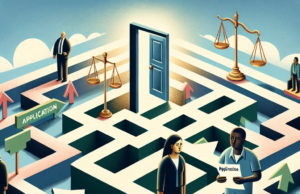
In an increasingly globalized world, the complexities surrounding immigration and legal status adjustments have become a focal point of discussion. As individuals seek to navigate the intricate pathways to legal residency, the realities of these adjustments often remain shrouded in misunderstanding. This article aims to unveil the truth about legal status adjustments, exploring their definitions, processes, misconceptions, impacts, challenges, and future trends.
Understanding Legal Status Adjustments: Definitions and Key Concepts Explained
Legal status adjustments refer to the processes through which individuals change their immigration status to become lawful permanent residents or citizens of a country. This can include various pathways such as family sponsorship, employment-based adjustments, asylum applications, and more. Key concepts in this realm include “adjustment of status,” which allows individuals already in the country to apply for permanent residency without leaving, and “consular processing,” which requires applicants to apply from their home country. Understanding these definitions is crucial for anyone considering a legal status adjustment, as they form the foundation of the immigration process.
The Process of Legal Status Adjustment: Steps and Requirements You Should Know
The process of legal status adjustment typically involves several critical steps, beginning with determining eligibility based on the specific category under which one is applying. Applicants must gather necessary documentation, including proof of identity, eligibility, and any supporting evidence relevant to their case. Following this, they must submit the appropriate forms to the relevant immigration authority, often accompanied by a fee. After submission, applicants may be required to attend an interview, undergo background checks, and provide biometric data. The entire process can take several months to years, depending on the complexity of the case and the backlog of applications.
Common Misconceptions About Legal Status Adjustments: Debunking the Myths
Despite the importance of legal status adjustments, numerous misconceptions persist. One prevalent myth is that all immigrants can easily obtain legal status if they have lived in a country for a certain number of years. In reality, eligibility is contingent upon specific criteria that vary by immigration category. Another common misconception is that legal status adjustments guarantee citizenship; however, many individuals may remain permanent residents for years without ever applying for citizenship. Additionally, some believe that hiring an attorney is unnecessary, but legal expertise can significantly enhance the chances of a successful application by navigating the complexities of immigration law.
The Impact of Legal Status Adjustments on Individuals and Communities
Legal status adjustments have profound implications for both individuals and the communities they inhabit. For individuals, obtaining legal status can lead to enhanced job opportunities, access to healthcare, and the ability to travel freely. It also fosters a sense of belonging and security, allowing individuals to contribute more fully to society. On a community level, legal status adjustments can stimulate economic growth, as newly legalized individuals often participate more actively in the workforce and local economies. Furthermore, diverse communities benefit from the cultural enrichment brought by immigrants who can now fully engage in civic life.
Legal Status Adjustments: Challenges and Barriers Faced by Applicants
Despite the potential benefits, applicants for legal status adjustments often encounter significant challenges and barriers. One of the most daunting obstacles is the complex and often opaque nature of immigration laws, which can vary widely by jurisdiction and change frequently. Additionally, financial constraints can hinder applicants, as legal fees and application costs can be prohibitive. Language barriers and lack of access to reliable information further complicate the process, leaving many applicants feeling overwhelmed and uncertain. Moreover, the emotional toll of navigating a system fraught with uncertainty can lead to anxiety and stress for individuals and families seeking legal status.
Future Trends in Legal Status Adjustments: What to Expect in the Coming Years
Looking ahead, the landscape of legal status adjustments is likely to evolve in response to shifting political climates, economic needs, and social movements. There is a growing recognition of the importance of immigration reform, which may lead to more streamlined processes and increased pathways for legal status adjustments. Additionally, technological advancements are expected to play a role in simplifying application processes, with online platforms becoming more prevalent for submissions and tracking. However, challenges remain, particularly in the face of potential policy changes that could restrict access to legal status. Advocacy efforts will be crucial in shaping a more equitable immigration system that recognizes the contributions of immigrants to society.
In conclusion, understanding the realities of legal status adjustments is essential for individuals navigating the immigration system and for communities seeking to foster inclusivity. By debunking myths, recognizing challenges, and anticipating future trends, we can better appreciate the complexities of legal status adjustments and work towards a more informed and compassionate approach to immigration. As the dialogue surrounding these issues continues, it is imperative to advocate for policies that support fair and just pathways to legal residency for all.



























